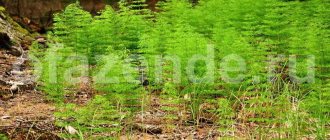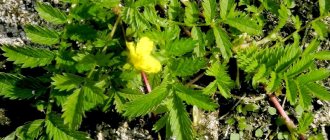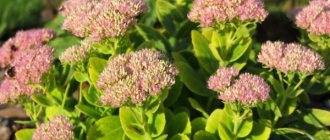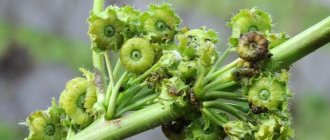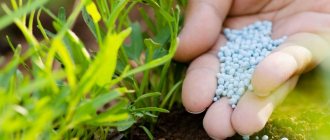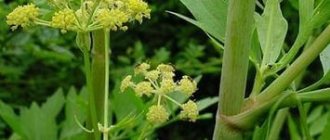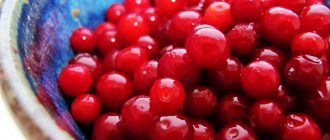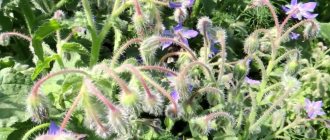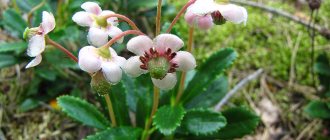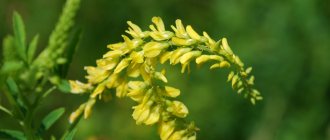Bearberry - description of the plant, where and how it grows, photo
Bearberry is a medicinal plant from the Ericaceae family, considered an excellent diuretic (diuretic). It grows in the form of bushes up to two meters high, but is not found in large thickets.
“And trees grow on rocks” - this is about her, since she has a very hard time tolerating the presence of other plants nearby and “prefers” places where there are fewer of them. It is light-loving, usually grows in open places, in pine and deciduous forests in central Russia, the plant is resistant to low temperatures.
Flowering lasts from May to June, after which small round red berries similar to lingonberries appear, usually in August-September. The leaves are small, round, soft to the touch.
By the way, not only bearberry berries are similar to lingonberries; the leaves, and indeed the entire plant, can easily be confused by novice collectors of forest resources with lingonberries, especially since their distribution area is very similar.
And these would-be amateurs ask questions: are bearberry and lingonberry the same thing or not ? Of course not, these are completely different plants, and they each have their own beneficial properties.
How to distinguish? Bearberry berries are tasteless, with a white powdery mass inside, reminiscent of oatmeal, and they are not suitable for the human diet; if you eat more than a couple of berries, you can get poisoned. Although for bears and hazel grouse they are simply delicious!
The leaves of the plants are also slightly different; in bearberry they are fluffy, similar to an ear with a thin base and a flattened top. The lingonberry leaf has dark spots on the underside.
Description, properties, features
You will have to refuse therapy using the plant in question in the following situations:
- during pregnancy and breastfeeding;
- inflammatory diseases of the stomach in the acute stage;
- acute kidney and intestinal diseases;
- constipation;
- food poisoning;
- age up to 12 years;
- frequent seizures.
The mushrooms Sarcoscypha coccinea have other names - elf's bowl, scarlet elf's bowl, and Belarusians call them granny's ears. Beautiful and interesting bear ears are very rare; they grow mainly in the north of the Irkutsk region. Here you can find mushrooms growing in large clusters, but sometimes mushrooms grow alone. You can find a circle of growing mushrooms, and most of them will be located strictly along the circumference.
Such very strange names for mushrooms were not given by chance, the fact is that the mushroom really looks like an ear, its stem is short, sometimes it may seem that it is not there at all. Their color can be different - red, orange, earthy gray. The leg is short, sometimes it may seem that it is not there at all.
You won’t find clearly defined spores in the mushroom, but on the ground, under the bear’s ear, there will be brownish-yellow dust.
Bear ears grow only in ecologically clean areas and are not considered dangerous, like most representatives of the mushroom kingdom, which have the ability to accumulate toxic substances. The main thing is not to make the wrong choice and not mistake the toadstool for an edible mushroom, although it is not so easy to confuse a toadstool with a bear's ear.
Decoctions and infusions based on bear ears can be used in parallel with drug therapy, incl. and antibiotics.
Pregnant women. The substances contained in bearberry have an irritating effect on the smooth muscles of the uterus, which can lead to its premature contraction. Nursing mothers. Since bear's ears are a diuretic, consuming decoctions and infusions from this plant can cause dehydration, which leads to decreased lactation.
Patients suffering from diarrhea. Substances contained in the leaves of the plant irritate the mucous membranes of the gastrointestinal tract (dill seeds for the pancreas are written in this article), as a result, indigestion increases and may be accompanied by vomiting. Patients with constipation. Tannins present in the leaves and stems of bearberry are characterized by an astringent effect and can aggravate constipation.
The material is presented for informational purposes only. We recommend that you discuss the use of medications with your doctor.
We invite you to watch a video about the beneficial properties of the medicinal plant bear ears.
The surprisingly mild and at the same time highly effective medicinal effect on human ailments that the bear's ears plant has puts it among the drugs that deserve the exclusive attention of traditional medicine specialists and herbal healers.
- Pregnant women. The substances contained in bearberry have an irritating effect on the smooth muscles of the uterus, which can lead to its premature contraction.
- Nursing mothers. Since bear ears are a diuretic, consuming decoctions and infusions from this plant can cause dehydration, which leads to decreased lactation.
- Patients suffering from diarrhea. The substances contained in the leaves of the plant irritate the mucous membranes of the gastrointestinal tract (this article is written about dill seeds for the pancreas), as a result, stomach upset intensifies and may be accompanied by vomiting.
- Patients with constipation. Tannins present in the leaves and stems of bearberry are characterized by an astringent effect and can increase constipation.
We invite you to watch a video about the beneficial properties of the medicinal plant bear ears.
Collection, preparation and storage of bearberry leaves
The collection of shoots and leaves can be carried out twice during the spring-autumn season, before flowering in April-May and after fruiting.
Autumn is the most favorable time for this; the amount of nutrients is much greater. The bear ears sheet is cut off or carefully torn off by hand. Under no circumstances should a shoot be pulled out by the roots.
Then the bearberry fruits and leaves are dried naturally in a well-ventilated, shaded area. The berries are dried in the same way, since these fruits do not have any special taste.
They can then be ground into flour (hence the name bearberry ) and used, like the leaves, as a base for preparing decoctions. You can store it in small fabric bags made of natural material, such as linen, calico or chintz; the shelf life is about 5 years.
How does bearberry treat?
The main active medicinal substances in bearberry are phenolic glycosides. arbutin, methylarbutin, piroside, caffeoylarbutin. Their content is very high, especially in the leaves (up to 25%!). Arbutin protects cell membranes from destruction due to low temperatures, dehydration and a number of other factors.
Common bearberry. Botanical illustration from the book by O. V. Thome “Flora von Deutschland, Osterreich und der Schweiz”, 1885
The diuretic and antiseptic properties of this plant are due mainly to arbutin and hydroquinone. After using bearberry, the content of hydroquinone in the urine reaches 1.7% and it becomes green. Hydroquinone, irritating the epithelium of the renal tubules, causes a weak diuretic effect, which is enhanced by flavonoids. All this ensures intensive removal of sodium and chlorine ions from the body.
Arbutin and hydroquinone also have antimicrobial properties. These substances inhibit the growth of many infectious agents. Currently, the use of bearberry in the treatment of sexually transmitted diseases is rapidly expanding.
Bearberry tannins also have similar properties. They form complex compounds with microbial proteins. and have an astringent effect on the mucous membranes of the stomach. It is noted that ellagic acid and arbucin prevent the development of spontaneous tumors by neutralizing free radicals. Bearberry flowers are used to treat heart disease, conjunctivitis and blepharitis. Decoctions of the fruit are used in the treatment of gastritis and diarrhea, this is especially effective for children (preparing jelly). Bearberry treats some skin pigmentation diseases.
Leaves of bearberry. © Przykuta
Bearberry herb - medicinal properties
The beneficial health properties of bearberry are not limited to the sphere of influence on the renal and genitourinary systems; they also successfully help in the treatment of diseases of the digestive system, metabolic disorders, and nervous system.
- Antiseptic;
- diuretics;
- anti-inflammatory;
- painkillers;
- astringents;
- enveloping;
- antibacterial;
- disinfectants;
- sedatives;
- regenerative;
- antioxidant - preventing premature aging;
- prevention of the development of cancer cells.
Bearberry and lingonberry differences
What is the external difference between bearberry and lingonberry? The best distinguishing feature is the leaves: in lingonberries they are curved down at the edges and have small black dots, while in bearberry they are completely flat and devoid of dots. In addition, a dense network of depressed veins is very clearly visible on bearberry leaves, while lingonberries do not have this. Upon careful examination, one can, of course, distinguish the fruits. You need to look at the top of the fruit. Lingonberries have a dense cluster of small sepals (the fruit of this plant is formed from the lower ovary, just like gooseberries). And in bearberry, the top of the fruit is completely smooth (the fruit develops from the upper ovary, like a cherry). These are the main differences between bearberry and lingonberry; knowing them, you can successfully identify plants in the forest.
The use of bear ears in folk medicine
The medicinal plant bearberry is in great demand both in folk and traditional medicine.
- Effective in the prevention of diseases of the genitourinary system, in particular the bladder (cystitis), kidneys (pyelonephritis, pyelitis) and prostate (prostatitis), it has a strong diuretic effect, helping to remove excess fluid from the body, eliminating swelling and normalizing kidney function.
- For a complex effect on the body, it can be used in combination with licorice root and cornflower flowers.
- It can also soften the effect of various allergic reactions, has a beneficial effect on disorders of the gastrointestinal tract, creating the necessary conditions for tissue restoration in case of stomach and intestinal ulcers, colitis, gastritis, will help with heartburn, and will relax constipation.
- A strong disinfecting effect was noted.
- Bearberry leaf is an effective natural sedative, restoring sleep-wake patterns.
- Bear ears are also beneficial for the skin - when used, facial wrinkles are reduced, skin tone is lightened, and inflammatory reactions are reduced.
- Bearberry is used for gout, rheumatism, diathesis, uterine bleeding, and diabetes.
Bearberry beneficial properties
Many plants have a positive effect on health and help in the treatment of various ailments. They are usually used as an adjunct to primary therapy. Bear's ear grass also has medicinal properties. What do bearberry leaves help with?
- The plant helps with inflammation.
- Bear's ear is a diuretic.
- Bearberry is an antiseptic.
- The leaves of the plant have antimicrobial and antibacterial properties.
- The herb has antioxidant properties.
- Bear's ear has a rejuvenating, whitening, cleansing effect.
Bearberry helps with heart and joint diseases, cystitis, urethritis, prostatitis, gastrointestinal diseases, and venereal diseases. The herb bear's ears is good for the kidneys. The plant is used for ulcers, eczema, edema, tumors, insomnia, depression, and alcoholism. The leaves of the herb help the eyes: they fight conjunctivitis and blepharitis. Bear's ear fruits also have medicinal properties. With the help of berries, stomach and duodenal ulcers, cholecystitis, gastritis, jaundice, hepatitis, and helminthiasis are treated.
For women
The unique composition of bear's ear makes it possible to use parts of the plant to treat female diseases. In gynecology, the medicinal herb fights leucorrhoea and is used for improper contraction of the myometrium - when, due to hypertonicity of the uterus, uterine bleeding may occur against the background of hormonal imbalance. Leucorrhoea is treated by douching with an infusion of the plant; uterine bleeding is stopped with the help of baths made from a decoction of herbal leaves. Bearberry leaves are used for cystitis. Some sexually transmitted pathologies can be treated using a bear's ear.
The medicinal plant is included in a set of weight loss measures. It removes excess fluid, accelerates metabolic processes, and improves the functioning of the digestive system.
Two full tablespoons of dry herb are poured into a glass of hot water, the infusion is kept for a day, and drunk half an hour before meals. You can make herbal tea with bearberry. A mixture of bear's ear herbs, string, corn silk, birch leaves, taken in equal quantities, is poured with boiled water, infused for 24 hours, then filtered. Drink half a glass after meals.
Bearberry during pregnancy
During pregnancy, the use of medications that contain bear's ear herb is contraindicated. The plant can increase the tone of the uterus, thereby causing miscarriage or premature birth.
If medicinal purposes require taking a herbal remedy, a pregnant woman should definitely consult a doctor and strictly adhere to the recommended dosages.
Bearberry contraindications, harm
- It is not recommended to use in case of renal failure or glomerulonephritis.
- In addition, bearberry leaves and berries may not be harmless during pregnancy (can cause miscarriage or premature birth), lactation, children under 12 years of age, individual intolerance to the components is possible.
Article on the topic: Herbaceous periwinkle - beneficial properties, description
If the collection is not carried out independently, but is purchased in a network of retail pharmacies, or in some other highly specialized stores, it will be useful to know how you can make sure whether this product is really what you are talking about. it is stated on the packaging. Can be confused with lingonberry leaves.
For this, a crystal of iron sulfate placed in the medium of bearberry infusion is useful, and if the liquid is first reddish and then purple in color, there is no doubt about its authenticity.
In a number of regions of Russia it is listed in the Red Book as an endangered species. It is recommended to use extreme care when handling.
Symptoms of overdose and the necessary diet when treating bearberry
Avoid overdose , which is fraught with possible discomfort in the stomach in the form of nausea and even vomiting, ringing in the ears, chills and fever, back pain - no more than 1 tablespoon 6 times a day for an adult.
When prescribing a course of this herbal infusion, it is recommended to reduce the amount of protein, fried, excessively salty foods, mushrooms in the diet, limit the consumption of baked goods, sweets, and also completely eliminate alcohol. As a replacement, you can use cereal porridge, raw vegetables and fruits.
Indications and contraindications for use
The medicinal properties of this plant are due to the complex effects of the ingredients contained in the dry phytomass. Bearberry can be used for:
- improved digestion;
- fight inflammation;
- destruction of pathogenic microorganisms;
- normalization of hormonal levels;
- removing fluid accumulated in tissues;
- relieving spasms;
- detoxification;
- eliminating pain;
- strengthening the immune system.
These effects determine the use of the plant in medicine. Doctors prescribe bearberry to treat the following diseases:
- Urinary system. Bear ears are used for pyelonephritis, pyelitis, urethritis, renal failure, and kidney stones. This herb helps well against cystitis of any origin.
- Digestive system. Used for gastrointestinal diseases associated with acute or chronic inflammation of the mucous membrane. It is especially recommended to use the plant to combat diarrhea caused by poisoning.
- Nervous system. Thanks to bear grapes, a person relaxes. This happens mainly due to the elimination of excess fluid and tension in the muscles.
- Leather. External products based on bearberry are used to treat purulent wounds that do not heal for a long time.
In folk medicine, this plant is used as a hemostatic agent for colds, attacks of bronchial asthma, rheumatism, and sexually transmitted diseases. In veterinary practice, bear grass is used when blood appears in the urine of pets.
To obtain a positive result from treatment, you should adhere to contraindications for use
Despite its wide range of uses, this plant cannot always be used for its intended purpose. Bearberry contraindications apply only to:
- pregnancy and lactation;
- under 12 years of age;
- patients with diabetes, pancreatitis, anemia;
- renal colic;
- cases of individual intolerance or atypical reaction.
It is not recommended to combine the use of this plant with drugs that acidify urine.
Thus, the beneficial properties and contraindications of bearberry are based primarily on the ability to stimulate kidney function, as well as on the antibacterial and protective effects on the gastrointestinal tract.
Possible side effects and complications
When using preparations from bear grass, a person’s urine turns green. However, this fact should not cause alarm. It only indicates that the process of cleansing the body is working.
Bear's ear herb can become a strong irritant to the kidneys with prolonged exposure. In this case, preparations are used that allow, while maintaining the therapeutic effect, to reduce irritation.
The diuretic effect leads to a deficiency of minerals and vitamins, so it is recommended to combine bearberry treatment with a course of vitamin-mineral complexes.
Side effects in the absence of allergies appear as:
- dyspepsia;
- nausea and vomiting;
- peristalsis disorders.
With an overdose or long-term use of bearberry preparations, inflammatory processes in the urinary system may worsen.
Traditional medicine widely uses recipes with bearberry for the treatment and prevention of various diseases.
Folk recipes for infusions, tinctures and decoctions with bearberry
The beneficial properties of bearberry herb are realized in a variety of folk healing recipes. We will look at preparing infusions, decoctions and vodka tinctures at home.
- Infusion. Dried leaves of bear ears are filled with water at room temperature and infused for 12-20 hours.
- 1 tbsp. l. Dry bearberry leaves are poured with 200 ml of hot water (not boiling water), left for 2.5 hours, filtered, diluted to taste with boiled water. The infusion is ready. Drink a tablespoon of it three times a day and store it in the refrigerator for a couple of days.
- Decoction 1 tbsp. l. crushed dry leaves of the bearberry plant are poured with 200 ml of boiling water and kept in a water bath for a quarter of an hour. Let it brew for an hour, then strain and bring again to 200 ml. adding boiled water. Take decoction three times a day 30 minutes after meals. The broth will keep in the refrigerator for two days.
- Tincture. Preparing tincture is also easy - 4 tablespoons of crushed bearberry herb is poured into a glass of high-quality vodka. The product is infused for 14 days, after which it is filtered and consumed 15 drops three times a day. For example, for the treatment of cystitis, urethritis.
How to drink as an energy drink
The medicinal substance is used for medicinal purposes and to increase performance, charge energy and tone the body. The substance produced in the form of an energy drink is recommended for people to restore vitality during frequent physical activity.
To prepare the drink, you need to pour 10 g of crushed dry collection into 0.200 liters of boiling water. Simmer for 5 minutes. Strain the product and use 1 tbsp. after meals every 4 hours. The duration of taking the energy drink is up to 21 days.
Mullein "bear's ear": medicinal properties, contraindications
The tall stem of mullein with bright yellow flowers stands out in its appearance among the meadow vegetation. This is one of the largest species of steppe and forest-steppe forbs in the temperate zone of Eurasia. Due to its impressive size and fiery coloring of flowers, the plant received many descriptive names among the people: royal candle, royal scepter, bear's ear, common mullein. The Latin taxon used in botany is verbascum.
In nature, mullein grass is considered a weed. Unpretentiousness and adaptability have led to the widespread distribution of the plant on the Eurasian, African and North American continents. Mullein feels good on poor sandy soils, so it is confined to forest edges, wastelands, and roadsides.
The attractive appearance served as a reason for the development of ornamental plant varieties. They are used in landscape design for landscaping areas. In total, more than 250 varieties of mullein are known.
The grass has a long tap root that penetrates deep into the soil. The straight stem extends to a height of up to 3 m. Near the soil surface there is a rosette of leaves attached to the shoot on long petioles. Along the rest of the stem, the leaves are arranged in a spiral or opposite each other.
The leaf blades are characterized by a heart-shaped or oval shape. A distinctive feature of mullein is the felt-like pubescence of the vegetative organs of the plant. The leaves and stem are grayish-green or dark green in color.
The upper part of the shoot ends in an inflorescence. It appears in perennial forms in the 2nd year of life. In the inflorescence, the upper and lower tiers are clearly distinguished. From 4 to 7 large flowers grow below, and from 1 to 4 small corollas at the top. A kind of cone or scepter of flowers is formed.
The plant blooms throughout the summer. After pollination, a fruit-box is formed in place of the flower. The outside is covered with thick short hairs , and the inside is occupied by yellow-brown seeds.
Arctotis: varieties and varieties
Among all the types of arctotis, there are several of the most common in the world and among our amateur gardeners.
- Acaulescent. Perennial. Flowering occurs throughout the summer. A distinctive feature of this species is its powerful root system.
Stemless Arctotis
- Hybrid. A perennial grown in the middle latitudes of Russia as an annual plant. It has semi-double baskets from 5 to 7 cm in diameter. It is possible to observe beautiful flowers only on a sunny, fine day. A famous variety is Archley.
Hybrid arctotis
- Short-stemmed. The plant is grown as a perennial, annual and biennial. Its flowers have a distinct orange hue. Wintering in open ground is contraindicated. Cultivated for over 200 years.
Short-stemmed Arctotis
- Stechasolist. Grows wild in southern Africa.
Stechasolifolia arctotis
- Rough. A perennial plant whose height reaches half a meter. It has yellow flowers with brown patches shaped like reeds.
Rough Arctotis
Collection and storage rules
Bear's ear grass is usually harvested during flowering. All parts of the plant have healing properties and can be useful for traditional medicine. Mullein is collected in the morning only in dry, clear weather. We must wait for the plant to dry completely after the night dew. In rainy weather, damp shoots and leaves should not be torn.
It should be remembered that the flowers bloom for only one day. It is at this time that they are picked off, without waiting for them to wither. However, the large number of buds on one stem allows the collection to be carried out for a long time.
Selected corollas, leaves, fruits and stems are dried under a canopy or in special dryers at a temperature of +50 C. The plant should not be left in direct sunlight. Due to their influence, mullein flowers burn out and lose their healing properties.
Related article: Rostkovius eyebright - beneficial properties, description
Harvested dry raw materials are stored for no more than 2 years. To preserve flowers, I use glass or tin containers with hermetically sealed lids. Leaves and stems are packed in paper bags or wooden boxes.
When harvesting, you must remember that the ratio of dry and fresh flowers is approximately 1:8. That is, from 8 kg of fresh plant, 1 kg of dry harvest is obtained.
Bearberry fruit - berry
The flowers are collected in short drooping apical racemes. The corolla is pale pink, five-toothed, pitcher-shaped with five stamens.
The bearberry fruit is a red five-seeded, mealy, spherical berry 6-8 mm in diameter. Blossoms in May, bears fruit in July - September. Bearberry berries are not edible and are not used in cooking.
Bearberry bushes can most often be found in rare pine forests. Its creeping branches, usually no more than one and a half meters long, form thick, squat crowns, resembling pillows of dark green velvet, as if scattered on a wide light bed of fallen pine needles. Often bearberry islands, merging, spread out in fluffy carpets, often covering many hectares each.
The bearberry flower is also original in its internal structure. The base of its jug is usually filled with fragrant nectar. There are many lovers of this delicacy, but bearberry gives it to only a few. Getting to the nectar located at the bottom of the flower, the bee, for example, accidentally catches the horns of the stamens sticking out in different directions with its fluffy abdomen, and knocks over the anthers hanging on them. In each subsequent flower, it leaves pollen and, thereby facilitating the fertilization of flowers, provides a vital service to the bearberry. But the sweet slug has to crawl from one flower to another for a long time, and it doesn’t know how to carry pollen on itself. For such unwanted visitors, the flower has erected barriers made of hard, prickly hairs that function flawlessly.
A flower fertilized by a bee or other beneficial insects hurries to form an ovary and shed its now useless outfit. Just yesterday the corollas were pink and white and fresh, but today they have wilted and become dull. Small bearberry fruits do not hesitate to develop either, fully ripening by August.
The modest forest bearberry produces up to 250 kilograms of berries per hectare. In addition, it has another very significant advantage - it has almost no deficiencies, which gave it special value in the past as a substitute for cereals.
Bearberry lives up to 80 - 100 years. The plant reproduces mainly vegetatively.
Look how the bearberry grass grows - the photo shows flowering and fruiting bushes:
Chemical composition and properties
The chemical composition of the mullein plant is rich in useful substances. Among them are:
- mucus;
- saponins;
- glucose;
- alkaloids;
- tannins;
- iridoids;
- coumarins;
- essential oils;
- carotene;
- gum.
One of the most important components is vitamin C. It has a stimulating effect on the central nervous system and promotes blood formation processes. Ash has disinfectant and antiseptic properties. It also prevents the formation of blood clots and speeds up the healing of wounds.
The presence of mullein and saponins in the grass helps remove phlegm and mucus from respiratory diseases. In addition, saponins prevent the development of tumors at the DNA level.
Preparations based on bear ear have medicinal properties:
- enveloping;
- pain reliever;
- anticonvulsant;
- expectorant;
- emollient;
- antiseptic.
Medicinal composition of bearberry
organic acids (malic, quinic, formic); phenolcarboxylic acids; phenols; catechins; flavonoids; tannins; resins; microelements; spectrum of B vitamins; vitamin C; essential oils; coumarins.
Nutrients accumulate as much as possible before flowering and after fruiting. The value of bearberry in medicine is its pronounced diuretic effect. It is due to the content of arbutin glycoside in the leaves, a biologically active compound with diuretic activity. It should be noted that all parts of the bearberry plant have a unique healing effect.
— bearberry leaf extract — lingonberry leaves — cranberry fruits — horseradish root extract
Bearberry is an evergreen shrub that delights the eye with its blooms in spring and bright berries in autumn, and has enormous medicinal potential. This plant also has another name - bear ears or wolf berry; other names of the shrub are also known, but they are rare. The beneficial properties of bearberry are determined by its rich chemical composition, which should be given attention when describing a specific plant.
To prepare medicinal products, the leaves of the plant are used, which contain a whole “pharmacy”. Among the component composition of bearberry there are:
- arbutin glucoside;
- flavonoids;
- ursulic acid;
- gallic acid;
- tannins;
- oils;
- micro and macroelements;
- vitamins C, A, B-group, etc.
Water pepper extract is a natural herbal preparation containing ethyl alcohol (its volume of the total mass is 70%).
The product has a hemostatic effect. This is possible due to the effect on blood clotting and capillary permeability.
In the case of uterine bleeding, their amount is reduced due to the effect on the strength of uterine contractions. With strong contractions, the vessels and capillaries are compressed, thereby reducing the force of bleeding.
The effect of using the drug is cumulative.
The components processed by the body are partially excreted in the urine and bile. Some of them are accumulated by the body in the form of glycogen (glucose).
Application
Common mullein, the medicinal properties and contraindications of which are described, successfully copes with many diseases
Medical recommendations
People use mullein as a diuretic. Rubbing fresh juice removed warts from the skin. Powder from the roots has long been known for its anthelmintic properties. To treat scrofula and rickets, patients are recommended to take baths with the addition of infusion or plant extract. Washing with a decoction of the leaves relieves inflammation of the eyes, and applying compresses helps get rid of lichen and hemorrhoids. Powder powder promotes rapid healing of wounds and cracks on the limbs and body.
Freshly picked mullein flower helps prevent bruising. To do this, just apply it briefly to the site of the bruise, the pain quickly subsides, and the bruise disappears in 2-3 hours. An infusion of flowers is effectively used to solve dermatological problems, baldness and psoriasis.
Herbal medicine recipes
The infusion helps cope with diseases of the upper respiratory tract, tuberculosis, pneumonia, bronchial asthma, whooping cough, epilepsy, jaundice, convulsions, and migraines. Added to water for taking medicinal baths for hemorrhoids.
1 dessert spoon of dry collection
Dry raw materials are brewed with boiling water and infused for 10 minutes. The finished liquid is filtered. Dosage 150 ml after meals 3 times a day.
The tincture has a beneficial effect on diseases of the stomach and spleen, as well as pathologies of the upper respiratory tract. As an external remedy it is used for rubbing for arthritis, neuralgia, radiculitis, rheumatism.
1 tbsp dried flowers
Mullein flowers are poured with alcohol and infused for 3 days.
Dental, cardiovascular, and gastric diseases can be treated with a decoction of common mullein. It is also used to make lotions for dermatological diseases.
1 tbsp dry leaves
The dry collection is filled with liquid and boiled for 2 minutes. Then it settles for 30 minutes and is carefully filtered. Drink 1 tablespoon of decoction 3 times daily.
Mullein oil received the name “royal”. It has excellent antiseptic and analgesic properties. It is recommended for healing wounds and eczema, eliminating ear pain.
100 ml olive oil
The flowers are laid out in a transparent bowl and filled with oil. The mixture is infused for 1 month, in a warm, well-lit place. The vessel is shaken daily to prevent sediment from accumulating. The finished oil is filtered and stored in the refrigerator.
The ointment is applied to disinfect wounds and ulcers and prevent rotting.
The grass seeds are ground into powder and then thoroughly mixed with butter in a ratio of 6:12.
Bear's ear: planting, reproduction and care
Arctotis is generally unpretentious, and anyone can grow it in their garden. The plant is warm and sun-loving.
Advice. Limestone soil works well for Bear Ear. It should be drained a little. Make sure the soil is loose and light.
Watering should be moderate; the plants do not like drought, but will not tolerate excess moisture. Don't forget where it comes from!
Advice. In order for arctotis to be abundantly covered with baskets, it is necessary to remove buds that have already bloomed.
Arctotis is grown by propagating seedlings or directly into open ground. Preparing seedlings should begin in mid-March.
Arctotis seedlings
- Seeds are sown in pots.
- Cover the pots with film.
- After 1.5–2 weeks you will be pleased with the first shoots.
- After a month, the seedlings can be planted in peat soil. Until this point, you need to control the watering of the plant.
- In mid-May, the seedlings are moved into open ground.
The second option for planting Bear's Ear is growing from seeds directly in open ground. This method is suitable for southern regions with warm climates. Planting takes place in early May. Seeds need to be planted at a large distance from each other. After 1.5 weeks, shoots appear. And with careful care, arctotis will bloom for the first time in 2 months.
Attention! In damp soil with a high clay content, arctotis may die.
Caring for bear's ear is no different from caring for many other perennials. Tall flower specimens need vertical support. You should also periodically weed and loosen the soil.
Arctotis seeds
No special fertilizers or plant feedings are required. You need to add mineral fertilizers once when planting arctotis.
Attention! Excess organic fertilizers will cause plant roots to rot.
Contraindications
There are no clear contraindications for common mullein. Pregnant and lactating women and young children should refrain from using herbal medicines based on it. When taking medications, it is necessary to take into account individual intolerance to individual components in the chemical composition of the herb. The appearance of discomfort or allergic reactions may also serve as a basis for contraindication to the use of the plant.
However, care must be taken when using individual parts of mullein. Liquid medications must be filtered to prevent lint from entering the esophagus and stomach. Thin, hard hairs in contact with the mucous membrane will cause irritation.
Bear ear seeds contain toxic substances and are therefore dangerous to eat. Tannin, which is part of the herb, has a carcinogenic property. In this regard, there is a severe contraindication for the inclusion of herbal remedies based on mullein in the treatment course of cancer patients.
To cleanse the body of waste and toxins
To cleanse the body of toxic substances and accumulated slag deposits, bearberry tea is perfect. The drink is brewed in a thermos from 6 thoroughly washed grass leaves and 0.2 liters of boiling water is poured. Infuses for 1 day.
The medication should be taken several sips per day. To get positive results, you should use the product for at least 2 weeks.
Place of growth
Bear's ear is a perennial herbaceous green plant. This shrub belongs to the Heather family. It has a low, thin stem and a widely growing tenacious root system. Blooms from April to June. The flowers are white and pink. The leaves are semi-oval, thick, mealy inside. The berries are red, sour-tart taste. Depending on where it grows, bear's ear has other names: bearberry, bear's ears, bear's berry and others. And it grows in cold mountainous places. This is mainly the North, Western Siberia, the Far East, the Baltic countries and Transcaucasia.
Article on the topic: Spring primrose - beneficial properties, description
Description of bearberry
Bearberry is a small evergreen shrub that looks a little like lingonberry, but belongs to a completely different family - Heather. Its shoots are creeping and can reach one and a half meters in length. The leaves of bearberry are not oval like lingonberries, but oblong-obovate and really resemble bear ears in shape. At the ends of the branches in May-June, small pale pink flowers appear in drooping racemes. After a month and a half, they form spherical, red fruits (drupes). These fruits are edible and are sometimes used as an additive in bread baking.
Bearberry grows in open and illuminated places in pine forests, on sandy soil. A special feature of bearberry is the need for the presence of mycorrhiza-forming fungi in the soil. The range of this plant covers most of Europe, the north of the North American continent and Greenland.
Description of the plant
Back in the twelfth century, the plant with the above names was known as a medicinal plant. People prepared it for future use and used it to treat various diseases. The leaves, berries and stem were used as medicine. The bear's ear plant, or bearberry, looks similar to lingonberries and often grows next to it. But it is not difficult to distinguish it from other heather shrubs. The lower part of the lingonberry leaf has dark specks, while bearberry leaves are smooth. Each berry contains only five seeds. The plant is not afraid of the cold and its leaves remain green in frosty winters. Leaves and berries are richest in healing properties at the end of summer. Therefore, raw materials are harvested in August-September. Dry it in the shade or in the sun, which doesn’t matter. This is another feature of the bear's ear - when dried, its healing properties do not lose power.
general description
In folk medicine, the plant is used to treat diseases of the excretory system:
- cystitis;
- urethritis;
- pyelonephritis (kidney tea);
- pyelocystitis.
A decoction of bear ears also helps with prostatitis:
- it stimulates renal function, relieves inflammation and facilitates urination.
Compresses with bearberry decoction are used in the treatment of trophic ulcers, eczema and purulent wounds.
Using a decoction of bearberry berries, our grandmothers successfully treated gastritis and other gastrointestinal diseases:
- the astringent effect of the decoction used in the diet (written here) helps to stabilize intestinal function.
Substances contained in the berries accelerate the regeneration of the mucous membranes of the digestive organs, so decoctions and infusions of bear ears are effective for stomach ulcers (treatment with folk remedies) and duodenal ulcers.
Recipes based on bearberry are safe for small children, the main thing is not to overdo the dosage.
Bear ears are used as an alternative treatment for malignant tumors:
- The flavonoids and antioxidants contained in the plant inhibit the development of tumor cells.
.What do you know about healing recipes made from amaranth flour? Read about medicinal baking in this useful article.
The effectiveness of laundry soap against papillomas is written here.
The highest concentration of flavonoids is in the fruits and leaves of bearberry.
cystitis; urethritis; pyelonephritis (kidney tea); pyelocystitis.
it stimulates renal function, relieves inflammation and facilitates urination.
the astringent effect of the decoction used in the diet (written here) helps to stabilize intestinal function.
The flavonoids and antioxidants contained in the plant inhibit the development of tumor cells.
Composition and benefits of the plant
Many people have known for a long time that bear ears are a healthy herb. In its composition, it is very rich in essential oils, useful acids, minerals, tannins and other useful substances. Leaves collected during the flowering period have earned the attention of many doctors and traditional healers for their healing properties. The presence of tannins in the grass has an astringent effect. Helps get rid of intestinal disorders, promotes wound healing. The glucose and hydroquinone contained in the herb have a disinfectant and analgesic effect. The bear's ear is endowed with properties that relieve a person from many ailments. Improve and prolong his life.
People suffering from heart disease need to eliminate swelling. A good helper for this is bearberry. It is included in tinctures and teas, which are freely sold in pharmacies. They may also recommend you a bath product that will alleviate the condition.
Composition of grass
Bear's ear has a specific composition.
There is a list of substances included in the medicinal shrub:
- Tannins belonging to the pyrogallic class block the further spread of the inflammatory process throughout the internal organs. Thanks to their effect, a protective film is formed on the mucous membranes. They have astringent and bactericidal properties.
- Vitamins soluble in water and fat: folic acid, pantothenic acid, ascorbic acid, nicotinic acid, tocopherol, carotene.
- Carboxylic acids : ellagic, citrate, malic, salicylic. They have a positive effect on the digestive process. Stimulates the functioning of the myocardium, contributes to the expansion of the lumen of blood capillaries. Produces a fungicidal and antiviral effect.
- Essential oils.
- Macro- and micro-type elements : iron, nickel, calcium, magnesium, zinc, barium, selenium, calcium, phosphorus, manganese, aluminum.
- Bioflavonoids – myricitrin, quercetin, hyperoside, quercitrin. They promote normal excretion of internal fluid by the kidneys, stimulate the adrenal glands, and help reduce blood pressure. The substances have the ability to block the growth of mutation cells, stopping the development of malignant tumors. With the simultaneous administration of ascorbic acid, the strength of blood capillaries increases.
- Glycosides - methyl arbitin, arbutin have an antiseptic effect.
Bear's ear is a herb whose use is possible due to its unique composition. It affects almost all systems of the patient’s body. But before any use of a medicinal plant, you need to consult a doctor and identify contraindications.
Use of bearberry
Bear ears are used in the form of infusions, decoctions, baths, powders, and ointments. Wounds are washed with solutions, lotions and compresses are made from them. The most common use of the herb is in the treatment of cystitis, inflammatory processes in the kidneys and bladder. The effect in this case is the most favorable: both for urinary incontinence and for relieving diuresis. The infusion for treatment is prepared as follows: 20 gr. dry crushed bearberry (bear's ear) leaves, pour half a liter of cold water and infuse for 10-12 hours. After this, the infusion is boiled for five minutes and filtered. Take 30 grams before meals (20 minutes before). It happens that the infusion causes nausea or diarrhea. To prevent this from happening, you must take 5 grams before using the drug. soda, washed down with water.
Possible side effects and complications
If you do not adhere to the established dosages and exceed the norm for administration, you can provoke a negative effect on the patient’s body. The side effects are especially pronounced on the functioning of the digestive organs, kidneys and uterus.
If any side or other negative effects are detected, you should immediately stop using the product and seek advice from your supervising doctor. If, during acute inflammation in the kidneys, you start taking bearberry supplements, it does not improve the effect, but, on the contrary, worsens it. This depends on the irritant effect the product has.
The same effect occurs on the mucous membrane of the digestive tract. The consequences of treatment are vomiting, painful discomfort in the stomach, and loose stools.
Bearberry can provoke the development of an allergic reaction: color the urine greenish, and also provoke the appearance of a rash and increased redness on the skin. Therefore, it is necessary to use the manufactured product strictly for its intended purpose and in a controlled dosage.
Thus, Bear's Ear helps to cope with various pathological processes that occur in the genitourinary system.
The herb also has a therapeutic effect on developing inflammatory processes throughout the body. It is important to fully comply with the technology for preparing recipes for treatment and the dosage for use, so as not to provoke side effects and overdose.
Author of the article: Alexandra
Article design: Oleg Lozinsky
Cooking recipes
Another recipe is no less effective: 10 g. leaves are poured with 20 ml of hot water and kept in a water bath for 10-15 minutes. Afterwards, everything is filtered through thick gauze, boiled water is added, up to 200 ml. Take a medicinal infusion of 60 ml, several times a day, before meals.
The bear's ear plant, the grass and berries of which are used to prepare a decoction, can also be used to prepare tinctures. It's easier and more convenient. In folk medicine, the tincture is recommended to be taken to normalize blood pressure. To do this, infuse 20 grams in 100 ml of forty percent ethyl alcohol. dried and crushed leaves for 15 days in a dry and warm place. After two weeks, everything is filtered and the tincture is ready. Take it 10 drops, three times a day, after meals. The tincture is used to treat the nervous system, in the fight against alcoholism, and to stop uterine bleeding.
Indoor flower bear ears. Bear ears grass: description, properties and scope of application
Bear's ear grass is an evergreen perennial subshrub with red berries that resemble lingonberries. The young plant looks like grass.
general information
The plant belongs to the Heather family. Bear's ear grass has other names. In different regions it may be called bearberry, bearberry, or tormento. Also in common parlance it can be called bear grapes, bear berries. In Finland, bearberry is called sianmarja - this name translated means “pork berry”.
- leaves are dense, round in shape, length 12-26 mm, width 4-9 mm;
- the flowers are white and pink, collected in bunches at the top of the stem, and have five teeth;
- the stem is thin;
- the shoots are long with numerous leaves (new ones from the bottom are greenish in color, and old ones are painted red).
This plant loves cool weather, like blueberries and cranberries. It has become widespread in Canada, Siberia, and Europe. The shrub is distinguished by the fact that it spreads along the ground and can cover entire clearings. The length of the shoots reaches two meters. The flowering period is May, the berries ripen from July to September.
Bear ears grass in the field
The plant has medicinal properties. Among them: diuretic, antiseptic, hemostatic and other properties. Traditional medicine uses all parts from flowers to roots.
Varieties
Bear grass has more than 50 different species. The two most popular are:
- Alpine bearberry. Grows in Russia, Scandinavia, Scotland, Canada. Length from 10 to 30 cm. Leaves have teeth. With the onset of autumn, the leaves change color to red. The fruits have a dark purple color. The herb is used for pathologies in the kidneys and for the treatment of the urinary and reproductive systems.
- Common bearberry. Grows in Russia, North America, Siberia. Length from 5 to 30 cm. The shape of the leaves is oblong. The berries are bright red. Used in the treatment of urolithiasis and disorders of the gastrointestinal tract.
The plant is rarely propagated by seeds. To do this, seeds are sown under glass in prepared soil and wait for germination.
Usually the subshrub reproduces vegetatively. The most commonly used propagation method is cuttings. This method is used in early spring using mixed peat and sand (1:1), preparing drainage. After one year, the plant is planted in a permanent place. In the spring, small holes are dug (depth 15-20 cm), at a distance of 25 cm. The root system is carefully covered with peat and pine litter.
The place for them should be slightly shaded or completely open to sunlight. The shrub does not tolerate other plants growing nearby. Heavy, loamy and clayey soils are unacceptable for bearberry. The bush cannot withstand a lot of moisture and stagnant water, so drainage is necessary. The plant can also grow in the mountains, and is found in the lichen tundra and in dry clearings.
Properties of culture
Bear's ear leaves are used in medicine.
They include:
- glycosides: have antiseptic properties, due to which the plant is used to treat the urinary system;
- organic acids: have a positive effect on the digestive system, metabolism, blood vessels, heart;
- tannins: form a protective coating on the mucous membranes, prevent inflammation;
- bioflavonoids (quercecin, myricitrin, hyperoside and others): affect the formation and excretion of urine, improve the functioning of the adrenal glands, normalize blood pressure, and stop the growth of cancer cells.
Use by Tibetan healers
In Tibetan medicine, bear ears, the use of which is very popular in the form of decoctions and tinctures, are used to treat sinusitis, Graves' disease, anemia, gonorrhea, and pulmonary tuberculosis. Ointments prepared from bearberry berries are used to treat sore joints and gout. Purulent wounds are washed with a decoction of the leaves. The plant is used in powder form for powders. The decoction is prepared as follows: 20 gr. dry leaves are placed in a container, preferably enameled, and 200 ml of boiling water is poured. Leave in a water bath for 15 minutes. Cool the broth at room temperature for almost an hour. Then it is filtered. The raw materials are squeezed out, and the broth is added with water, of course, boiled (up to 200 ml). Take half a glass (or 60 ml) several times a day a few minutes after meals.
Bearberry in cosmetology
In cosmetology, the leaves of the bear's ear herb are actively used to maintain beauty, youth of skin and hair. The plant removes pigmentation, brightens the skin and fights its problems, strengthens the hair.
- To remove pigmentation, use a decoction: 3 tbsp. spoons of grass leaves are poured with half a liter of water, heated in a water bath, and filtered. The cooled broth is used to wipe the areas with pigmentation several times a day.
- A decoction of the leaves of the plant can be used to wipe inflamed areas of the skin.
- For the face, the antioxidant quality of bearberry is used, which helps protect the skin from dryness, fight fine wrinkles, revitalize and rejuvenate it.
- To strengthen hair, use a decoction of the leaves of the bear's ear herb, which is used to rinse your hair after washing.
- Using a concentrated infusion of plant leaves, hair is lightened.
The cosmetic industry produces cosmetics based on bear's ear. For example, Clean Line has a cream that caters to dry, sensitive skin. "Credo Natural" produces a cream for cleansing pores.
Where does bearberry grow?
It grows in the northern and central zone of the European part of Russia, in Western Siberia, in all regions of Eastern Siberia and the Far East. Occasionally found in the mountains of the Western Caucasus. These are not all the places where bearberry grows wild; there are many more of them.
In the Urals, bearberry grows almost exclusively in the highlands; it is most often found in the Northern Urals; in the flat part, its locations are associated with dry pine forests.
Bearberry is often found in light-colored pine forests because it is a light-loving crop and does not compete well with other forest inhabitants. It settles in poor habitats with sparse stands, and with a lack of moisture in the soil, its leaves become brown, become coarse and the entire plant stops its growth.
Arctotis care
The plant needs good lighting. Otherwise, caring for it is easy. Weeding, loosening the soil, and watering in dry weather are necessary.
The soil for growing should be light, well-permeable to moisture and air. Preferred areas are rich in lime. Acidic soil must be limed before planting.
In summer, arctotis is watered abundantly, but rarely. The flower cannot tolerate excess moisture in the soil; it is relatively drought-resistant. The tap root penetrates to a considerable depth and can obtain the necessary moisture.
Bear's ear does not like fresh organic fertilizers. The plant responds well to the application of complex mineral fertilizers during budding.
In central Russia, arctotis overwinters only indoors; watering at this time should be moderate. To make it easier to move the flower to winter, it needs to be grown in a flower pot. With the onset of autumn cold weather, the plant is brought into a heated room, and in the spring, at the end of April, it is taken out into the garden.
- Author: Maria Sukhorukikh
Rate this article:
- 5
- 4
- 3
- 2
- 1
(0 votes, average: 0 out of 5)
Share with your friends!

